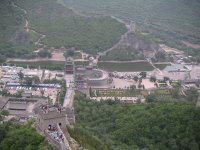A famous legend which is told for many generations thereafter is the Meng-jiangnu, whose husband was captured by Qin Emperor soldiers, not long their marriage, to build the Great Wall. Meng-jiangnu travelled 500km to find her husband had died. Meng-jiangnu cried and cried until a section of the Great Wall collapse and she eventually died. A temple was erected in her memory.
This wall was built with the aim of protecting China against attacks by the Mongol worriors who constantly raided the Chinese territory.




The part of the wall we visited, was said to be the "gate" or key to the city of Peking/Beijing and if this wall fall, then Peking/or Beijing as it is now known as, will fall to the enemies.

No comments:
Post a Comment